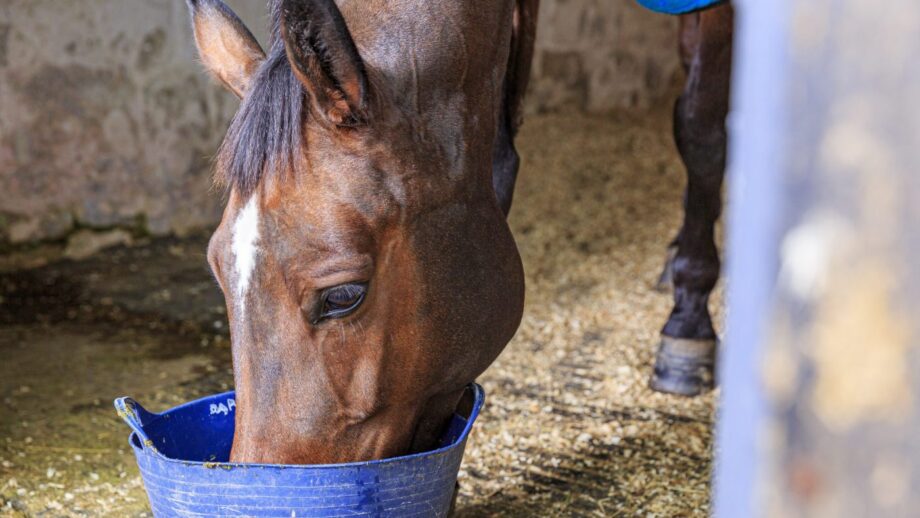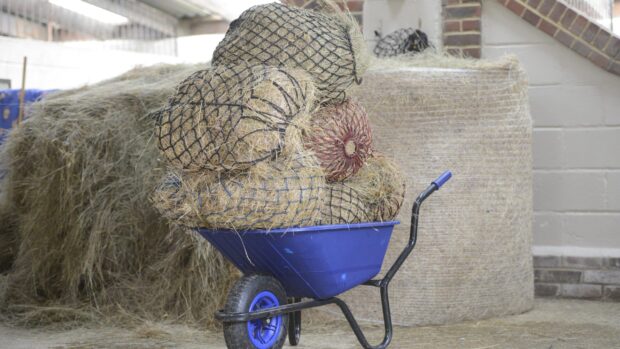If your horse is on the sharper side, you’ll know that riding, managing and feeding an energetic horse often requires a different approach to the laid-back good doer.
Winter routines usually incur changes to turnout, stabling, management and sometimes ridden work. For some horses, it means as much exercise as limited daylight and ground conditions allow. For others it could mean reduced hacking and more time spent under lights in an arena. If a horse has spent the summer season competing in full work, switching to winter management could mean a reduction in movement and energy expended. Where, then, does this energy go?
If you own a horse prone to spookiness or excitability, you might have noticed a seasonal change in behaviour. Some owners report that their horses become more energetic once clipping starts.
“Often around the time of the first clip, we get more calls to the Dengie Feedline with owners reporting that their horse is suddenly more excitable,” says Tracey Hammond MSc (Dist), Equine Nutritionist at Dengie. “Although there is no evidence to prove it, we suspect they are suddenly noticing the cold a little more!”
If you’re puzzling over managing and feeding an energetic horse, read on for expert tips.
Energetic horses: management considerations
Jane Buchan of Baileys advises a holistic approach to the energetic horse rather than rushing to change the feed immediately.
“Feed is often picked out as the culprit yet, while some feed ingredients can have an effect on temperament, many other factors are likely to be influential,” she says.
Stress
“Horses can be stressed in their environment and work for a plethora of reasons and it is our job to identify if they are stressed and why,” continues Jane, adding that stress and reactive behaviour are both signs of equine gastric ulcer syndrome (EGUS).
“The pain of the ulcers may be exhibited in stressful behaviour. If gastric ulcers are suspected, it is wise to have this investigated by the vet. Altering the horse’s management and feeding regimes can help, but veterinary intervention is recommended to ensure horses get maximum benefit from those changes.”
Turnout
We often think of turnout in terms of quantity, but Jane advises ensuring your horse’s time out is good quality, too.
“If they are not happy on their own or don’t like their companion, some experimentation may be necessary to find a turnout regime with which they are comfortable,” she says.
Stabling arrangements should also be taken into account.
“Some horses like to see what’s going on and be able to interact with other horses, while some may prefer a quieter situation,” says Jane. “In any case, when stabled, horses should always have access to forage or forage alternatives to satisfy their need to chew and produce saliva, which helps neutralise stomach acid.
“As a guide, a horse should consume ideally no less than the equivalent of 1.5% of his bodyweight in fibre per day so, if they don’t have access to grass or are not great eaters of hay or haylage, it may be wise to give them forage alternatives to boost their intake.”
Feeding an energetic horse: does feed affect behaviour?
Understanding how horses are fuelled by feed starts with understanding how that feed is digested and its energy released.
“Carbohydrates are the predominant energy source for herbivores such as the horse,” says Tracey. “The feedstuffs used for horses will vary in the proportions of the different carbohydrates they contain which largely determines their suitability for each horse.
“Carbohydrates include fibre, starch and sugar which vary considerably in how quickly they are broken down in the digestive system and therefore how quickly the energy they contain is released to the horse…”
- fibre is a slow-release energy source digested in the hindgut – the collective term for the caecum and large intestine – by its microbial population. The energy it produces is in the form of volatile fatty acids (VFAs)
- starch is a quick-release energy source primarily digested in the foregut – the collective term for the stomach and small intestine – by enzymes. The energy it produces is in the form of glucose if digested in the foregut. If starch reaches the hindgut it is broken down faster than fibre and produces stronger forms of the VFAs (acid)
- sugar is an even quicker release energy source because it is a simpler structure than starch when digested in the foregut. The energy it produces is in the form of glucose if digested in the foregut and VFAs if it reaches the hindgut
“Feedstuffs that are higher in sugar and starch provide quick-release energy,” continues Tracey. “Studies measuring blood glucose levels after feeding oats found that levels peaked 2 hours after feeding, whereas the levels of VFA in the hindgut peaked at around 5 hours after feeding a high-fibre diet.
“What needs to be considered here is that if horses are fed an ad-lib, forage-based diet, rather than meal feeds, there is less likelihood of a glucose “peak” as the horse is consuming their food more slowly, even though forages contain some sugar.”
Put to the test
In theory, slower-release energy sources – particularly ad-lib forage – should be less likely to contribute to excitable behaviour in energetic horses. But does this work in practice?
“To try and substantiate this with some more scientific evidence, Dengie worked with researcher Louise Bulmer to explore the effects of different energy sources,” explains Tracey.
“The trial compared the effects of feeding Alfa-A Molasses Free (containing 2% starch) with a cereal-based mix (22% starch) with the same energy level (11.5MJ/Kg DE).
“The horses wore heart rate monitors and their behavioural reactions were also recorded when presented with new situations, such as asking the horses to walk through a curtain of plastic strips.
“The study showed that horses fed the cereal mix were more reactive to new experiences than those fed the fibre and oil diet, and were less consistent in their behaviour. Interestingly they also had higher heart rates than those fed the fibre feed, which suggested they were in a more reactive condition and so perhaps more likely to shy or spook at the novel stimuli. The study has since been replicated in unhandled ponies to try to control for any possible human influence and the same results were found.
“This, along with other studies, provides evidence to back up the theory that fibre should be less likely to cause over-excitable and spooky behaviour .”
Feeding an energetic horse: expert recommendations
For Jane, feeding an energetic horse to match his energy output needs is key.
“That way, he won’t have excess calories to burn. Choosing a mix or cube that meets your horse’s condition and energy needs when fed at the recommended rate will help deliver this.
“Good-doers may get all the calories they need from forage alone so a low-starch, high-nutrient balancer is ideal for providing essential nutrients without the calories associated with a traditional mix or cube.
“Many people believe that a higher protein level can exacerbate excitability, but this is not the case. Protein is rarely used by the horse’s body as a source of energy.”
Jane’s recommendation comes in mix or cube form to suit a variety of palates.
“Baileys Ease & Excel Mix and Cubes are both formulated to be sympathetic to horse’s stomach and digestive system by being low in starch and sugar and providing high levels of slow-release calories from superfibres and oil.
“Both contain top-quality protein sources to build and repair muscle tissue, backed up with boosted levels of vitamins, chelated minerals and antioxidants to support performance, immunity and recovery. It’s ideal for any stressy or sharp horses as well as those prone to gastric ulcers.”
Tracey says: “For those that prefer the convenience of an all-in-one option, Dengie Healthy Tummy is a good choice,” she says. “It is a nutritionally complete fibre feed for optimal digestive health and when fed at the recommended feeding rate, does not require an additional balancer or vitamin and mineral supplement alongside”.
“Healthy Tummy combines chopped and pelleted alfalfa with an oil coating, a high specification of vitamins and minerals, and added herbs for great palatability. Healthy Tummy also contains Protexin In-Feed Formula that supplies prebiotics and live yeast for optimal fibre digestion and digestive support. Based on entirely ‘slow-release’ energy sources, Healthy Tummy is also useful for condition without the fizz.”
- To stay up to date with all the breaking news throughout Horse of the Year Show, London International and more, subscribe to the Horse & Hound website
You may also be interested in:

Helpful tips for feeding a good doer that lives out during the winter

Should you call time on feeding bran mash? Horse & Hound investigates…

Subscribe to Horse & Hound magazine today – and enjoy unlimited website access all year round




